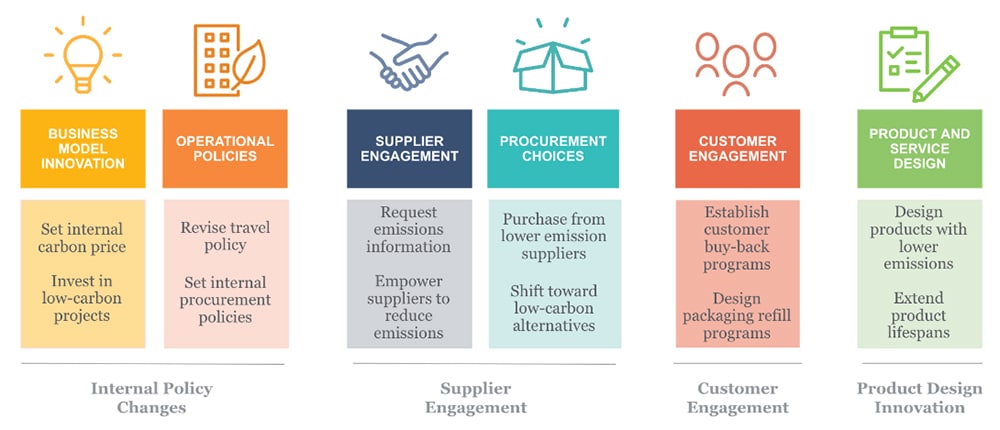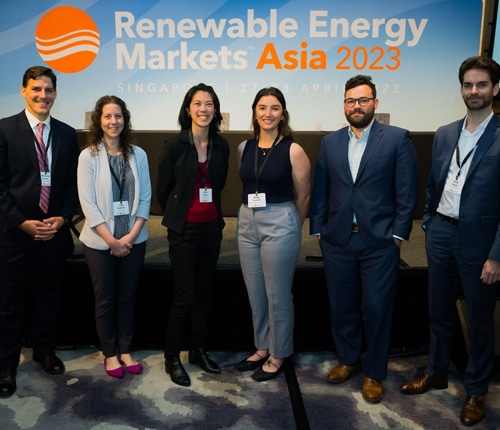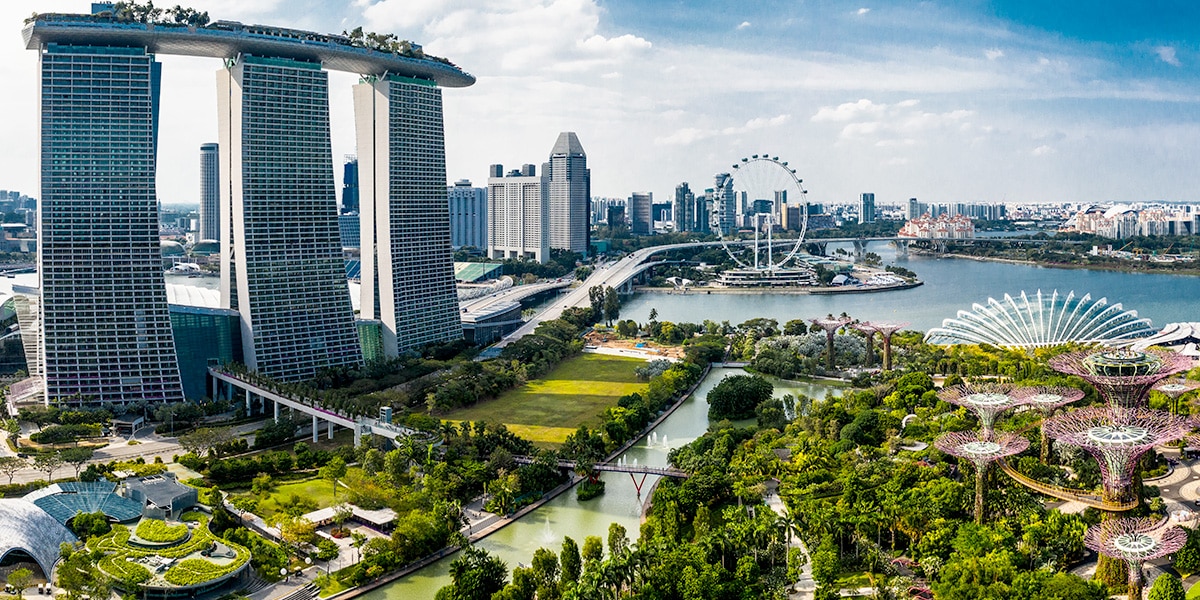Three years ago, a cohort of 3Degrees employees prepared to travel to Singapore for the inaugural Renewable Energy Markets (REM) Asia conference – a welcome expansion of the REM conferences that have been hosted by Center for Resource Solutions in the United States for over twenty-five years. However, due to the COVID-19 pandemic, this conference was rescheduled and held virtually the past two years. With conferences now returning to their pre-2020 norms, 3Degrees was finally able to attend the third annual REM Asia conference in Singapore at the end of April.
Representatives from our advisory services, renewable markets, product development, and market intelligence teams joined nearly two hundred renewable energy professionals from around the world to discuss emerging trends, market updates, and obstacles and opportunities related to renewable energy policy and procurement. 3Degrees played a leadership role at the conference by serving on REM Asia’s planning committee, moderating a panel session, and leading table topic group discussions.
Scope 3 decarbonization is a growing priority
Both our panel and table topic discussions addressed reducing supply chain emissions with a focus on promoting renewable energy procurement in the Asia-Pacific (APAC) region. Scope 3 emissions are the indirect emissions resulting from upstream and downstream activities in a company’s value chain. These emissions, which represent the vast majority of most companies’ carbon footprints, can be addressed by implementing internal policy changes, engaging with both suppliers and customers, and investing in product design innovation.
The focus of the panel was specifically on supplier engagement – or how companies can better understand the amount of emissions that result from their suppliers’ electricity consumption and then support their suppliers inthe procurement of renewable energy to address those emissions. This is increasingly important for many companies, especially the thousands of companies that have set science-based targets that often include scope 3 reductions. As electricity consumption forms the basis of nearly all fifteen scope 3 categories, supplier fuel switching to renewables is both an effective and efficient way to quickly reduce upstream value chain emissions.

Strategies for taking action to address scope 3 emissions.

Obstacles to supplier action are addressable
A common theme when discussing supplier engagement is that it is much easier said than done, and even the initial step of obtaining accurate emissions data has proven difficult for many companies. For instance, of companies that reported their emissions through CDP last year, just 39% utilized its Supply Chain initiative to request that their suppliers also report their greenhouse gas (GHG) emissions. Those that did participate, on average, only reached out to 34% of their suppliers, and less than half of these suppliers followed through with reporting their emissions. Furthermore, only a fraction of those suppliers that reported through CDP disclosed that they had a formal emissions reduction target in place.

Scope 3 decarbonization session moderated by 3Degrees
Despite these roadblocks, there’s an encouraging silver lining – there were nearly 41,000 suppliers engaged in CDP reporting last year, compared to just over 6,000 a decade ago. However, even when suppliers are successfully engaged, additional barriers to action frequently arise due to the cost of fuel switching, limited renewable energy procurement options in key APAC markets (and elsewhere around the world), and more complexities related to the allocation and communication of both upstream and downstream emission reduction claims across value chains.
Although these barriers add complexity to supplier action, they are far from insurmountable, and we increasingly encounter new success stories. For example, take Kingwhale, a global supplier of performance fabrics that spoke on the panel with 3Degrees, that is the first APAC-based textile manufacturing company to join the RE100 initiative and commit to procuring 100% renewable electricity by 2040. They have three sites in Taiwan with onsite solar and are providing investment support for their suppliers to also install onsite solar. What makes Kingwhale more impressive is that they made this commitment not due to customer demands or environmental regulation, but because they want to demonstrate their sustainability leadership and serve as an example to other suppliers in this space.
Other key conference themes
Beyond the increased relevance of supply chain engagement to address scope 3 emissions, there were several other important takeaways from the conference.
- APAC markets continue to mature and expand: Individual sessions were held on the state of renewable energy markets in China, Japan, South Korea, Philippines, and Taiwan. Each of these countries faces unique obstacles and opportunities, typically driven by the structure of energy policy and regulation. Despite some headwinds, renewables are expected to continue to penetrate these electricity markets, which are undergoing a transition not only away from fossil fuels but also in terms of greater reach, reliability, and access.
- Power purchase agreements (PPAs) are gaining momentum: Onsite, off-site, and virtual PPAs were referenced in the majority of sessions, with India, Australia, and Taiwan leading the region in terms of contracted capacity. Increased utilization of PPAs is expected in China, Japan, South Korea, Philippines, and Singapore, giving corporate buyers a way to increase their environmental impact and push for new renewables to be developed on these grids. While many of the successfully executed PPAs discussed are fairly bespoke case studies and not all markets currently allow for PPAs, there is strong demand for PPAs in APAC markets.
- Market boundaries remain a point of discussion: Conference attendees shared contrasting opinions on cross-border renewable energy consumption claims in the Association of Southeast Asian Nations (ASEAN) grid region. CDP-defined criteria clearly state that, in this region, a market boundary is the geographic border of each country, however, some market participants believe that more liberalized boundary rules are justified by the interconnectedness of these electricity markets.
- Forthcoming GHG Protocol changes loom large: World Resources Institute and World Business Council for Sustainable Development recently administered a survey to solicit stakeholder feedback on their Scope 2 Guidance. Attendees discussed how this feedback could affect reporting standards for purchased electricity, along with how they are seeking more localized approaches and guidance from the GHGP on the APAC region. Updates to the guidelines are not expected until 2025, so we expect this protocol revision process to continue to be discussed extensively at similar conferences over the next two years.

3Degrees attendees pictured left-to-right: Nick Hanson, Julie Casabianca, Amy Chiang, Haley Shewfelt, Noah Bucon, and Kesh Nayebi.
Clear prospects for continued market development
With renewable energy markets continuing to develop and evolve due to changing regulatory landscapes and increasing corporate action, 2023 is shaping up to be an influential year for these markets globally, but especially in the APAC region, which generally has less than 5-10% renewable energy penetration. We expect continued country-specific developments related to renewable energy procurement options, and we are committed to helping our clients understand these opportunities and address any barriers that exist to reducing their carbon footprints.
Please reach out to us with any questions on the use of renewables in your value chain and other impactful ways to understand and address your scope 3 emissions.


